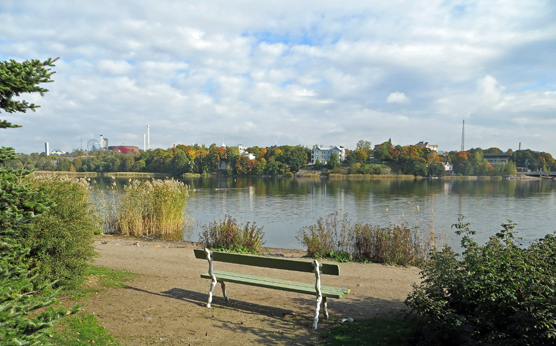Press release 2017-08-11 at 10:41

Töölö Bay © City of Helsinki / Helena Roschier
City of Helsinki environmental services and the Finnish Environment Institute:
The sea bottom near cities is often damaged by harmful substances introduced through human activity. The same environments also often suffer from eutrophication. A research project is being carried out in Töölö Bay to ascertain how a method previously used in upgrading soils could affect contaminated sea sediments and the eutrophication of the bay.
Equipment is being set up in Töölö Bay in August whose potential for breaking up harmful substances in the sediment, such as oil and PAH compounds, will be studied. The method could help avoid extensive dredging in the upgrading of sea sediments.
"The method has been in use in land areas, and with its help it has been possible to improve spoiled areas. The equipment produces a weak electric field in the area, which has been shown to accelerate the decay of harmful substances in soil. Now the aim is to ascertain how the method will work in an aquatic environment", says Iisak Lusua of Eko Harden Technologies Oy.
Method might also help control eutrophication
Preliminary investigations carried out in an aquatic environment have also suggested that the equipment could have an inhibiting effect on the internal nutrient input which maintains eutrophication. The purpose of the study at this stage is to ascertain the effects that the method would have specifically on the internal circulation of phosphorus.
"Töölö Bay has been selected as the target of the study because it is a eutrophied land-locked bay suitable for the study, and its need for revitalisation is evident. In addition, Töölö Bay is in a central location which eases the practical arrangements of the study", says researcher Emil Vahtera of the environmental services of the City of Helsinki.
The active field work will take about a year. Three research rafts will be anchored in Töölö Bay for the duration of the study. Conducting the research will not disturb the environment, nor will it require large structures or dredging. When the study is over the rafts and the equipment will be removed from the bay. After this the City of Helsinki will monitor the long-term effects of the method.
"The method for the remediation of sediments has not been tested very often in Finland so far. If this experiment is successful, the method could have a great potential elsewhere as well", says leading researcher Kirsten Jørgensen of the Finnish Environment Institute.
The research will be carried out as a cooperative effort of two different projects with the City of Helsinki, the Finnish Environment Institute, Helen Oy, Eko Harden Technologies Oy and Lamor Corporation Ab participating. The projects are getting funding from Tekes and the EU's H2020 programme and support from a partner, the dock manufacturer Lip-Lap Laituri Oy. The research project is also a commitment project of the Baltic Sea Action Group (BSAG) and the Baltic Sea Challenge.
Media invited to observe installation of the rafts
The research raft will be placed in Töölö Bay on the afternoon of August 14 and journalists are invited to follow the event from 14:00. The rafts will be placed in the water from the southern end of Töölö Bay. More information: Communications manager Johanna Joutsiniemi, City of Helsinki
Tel. 09 310 31565, 050 522 6708, johanna.joutsiniemi@hel.fi
Further information
Leading Researcher Kirsten Jörgensen, Finnish Environment Institute (SYKE)
Tel. 0295 251 245, kirsten.jorgensen@ymparisto.fi
Researcher Emil Vahtera, City of Helsinki
Tel. 09 310 70911, emil.vahtera@hel.fi
Head of project Miiro Jääskeläinen, Eko Harden Technologies Oy
tel. 040 7449263, miiro.jaaskelainen@ekoharden.fi